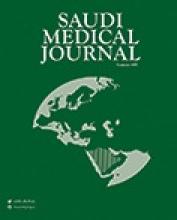To the Editor
I had the chance to read the interesting article by Al-Matham et al1 on Glomerulonephritis (GN) disease pattern at Saudi tertiary care center. A retrospective chart review on 166 kidney biopsies from 2007 to 2016 at a single tertiary referral center showed that 61.4% had primary GN and 38.6% had lupus nephritis (LN) in which class IV was the most common in 46.9% of patients. Clearly, such an epidemiological study can promote focused research on screening, preventing, optimizing medical treatment and finally improving the patient care. However, the lack of standardized and validated method for classifying and reporting GN limit such a goal, as some forms of GN are still not included in the latest classification by the Mayo clinic/Renal Pathology Society.2
In Saudi Arabia, previous studies showed that the frequency of LN was large and ranged between 47.9% -58.7%.3,4 But in this study, the cohort was 38.6%, perhaps due to the nature of the retrospective chart review as some of the data may be missed. Nevertheless LN class IV, still considered high risk for progression to ESRD in SLE patients. Interestingly, LN patients have a variety of clinical presentation ranging from asymptomatic urinary abnormality such as proteinuria, hematuria, to an overt nephritic or nephrotic syndrome that progress to chronic renal failure and ESRD. A study by Singh et al5 showed that from 163 biopsy proven LN, only 39% had an initial presentation of LN. A multicentre trial is needed, looking at the different presentation of LN and if there was any predictors for renal involvement that is specific to our patients cohort.
Reply from the Author
Thank you for your valuable comment. As you know retrospective studies with small sample size might face these challenges. Also being single center is contributing to this. We believe national registry for systemic lupus erythematosis is highly required. Multicenter studies also will be of great value to give better understanding about the different classes and presentation in Saudi Arabia.
Khalid AlMatham
King Fahad Medical City Riyadh, Saudi Arabia
- Copyright: © Saudi Medical Journal
This is an open-access article distributed under the terms of the Creative Commons Attribution-Noncommercial-Share Alike 3.0 Unported, which permits unrestricted use, distribution, and reproduction in any medium, provided the original work is properly cited.






